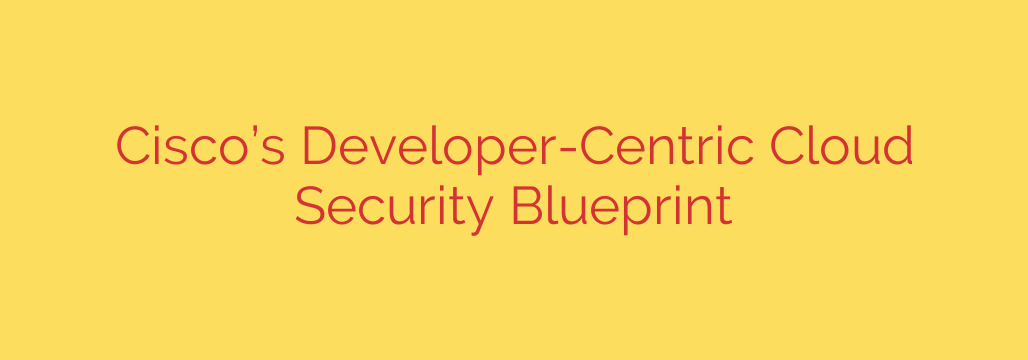
The Future of Cloud Security is Developer-Centric
In today’s fast-paced digital landscape, the pressure to innovate and deploy applications quickly has never been greater. However, this speed often creates a fundamental tension with security. Traditional security models, where a separate team acts as a gatekeeper at the end of the development cycle, are no longer effective. They create bottlenecks, frustrate developers, and ultimately fail to keep pace with modern cloud-native environments.
The solution is a paradigm shift: moving to a developer-centric cloud security model. This approach embeds security directly into the software development lifecycle (SDLC), empowering developers to build secure applications from the very beginning. It’s not about adding more tasks to a developer’s plate; it’s about providing them with the right tools and context to make security an integral part of their existing workflow.
Breaking Down Silos: Moving Beyond the Old Model
For years, security and development teams have operated in separate silos. Developers write code, and security teams scan it for vulnerabilities before deployment. When a flaw is found, the code is sent back, creating delays and friction. This adversarial relationship is inefficient and ineffective in a world of continuous integration and continuous deployment (CI/CD).
The modern approach, often called DevSecOps, recognizes that developers are the first line of defense. By equipping them with tools that provide immediate, actionable feedback, organizations can identify and remediate vulnerabilities much earlier in the process, when they are cheapest and easiest to fix.
The Pillars of a Developer-First Security Strategy
A robust, developer-centric security blueprint is built on several key principles that transform security from a roadblock into a streamlined, collaborative process.
1. Shifting Security Left
The core concept of this new model is “shifting security left,” which means integrating security practices at the earliest stages of development. Instead of waiting for a final security review, automated checks are run directly within the developer’s environment, such as their code editor or the CI/CD pipeline. This includes:
- Infrastructure as Code (IaC) Scanning: Before a single piece of cloud infrastructure is deployed, its configuration templates (like Terraform or CloudFormation) are scanned for misconfigurations. This prevents security gaps from ever reaching production.
- Software Composition Analysis (SCA): Modern applications are built on a foundation of open-source libraries. SCA tools automatically scan these dependencies for known vulnerabilities, ensuring the entire software supply chain is secure.
2. Context is Everything
One of the biggest failures of traditional security tools is alert fatigue. Developers are often inundated with a long list of potential vulnerabilities without any sense of priority. A developer-centric approach fixes this by providing context-rich intelligence.
Instead of simply flagging a vulnerability in a library, a modern security platform can determine if that specific piece of vulnerable code is actually being used or is reachable within the application’s code path. This allows teams to prioritize real, exploitable risks over theoretical ones, focusing their efforts where they matter most.
3. Comprehensive Cloud Native Protection
Effective cloud security requires a unified view across the entire application lifecycle. This is where a Cloud Native Application Protection Platform (CNAPP) becomes essential. A CNAPP integrates multiple security capabilities into a single solution, providing visibility from code to cloud. Key components include:
- Cloud Security Posture Management (CSPM): Continuously monitors cloud environments for misconfigurations and compliance violations.
- Cloud Workload Protection Platform (CWPP): Secures workloads (like containers and virtual machines) at runtime, protecting them from active threats.
- API Security: Discovers and protects APIs, which are a primary target for attackers in modern applications.
By combining these functions, a CNAPP eliminates security gaps and provides a single source of truth for both developers and security teams.
Actionable Steps for a More Secure Future
Transitioning to a developer-centric model requires both cultural and technological changes. Here are a few actionable tips to get started:
- Integrate Tools into Developer Workflows: Choose security tools that offer plugins for popular IDEs (like VS Code) and integrate seamlessly with CI/CD pipelines (like Jenkins or GitHub Actions). The goal is to make security invisible yet ever-present.
- Focus on Actionable Remediation: Don’t just show developers a problem; give them the solution. Good tools will provide code suggestions and clear instructions on how to fix a vulnerability directly.
- Foster a Culture of Shared Responsibility: Encourage collaboration between development, security, and operations teams. Security should be seen as a shared goal that enables the business to move faster, not a department that says “no.”
- Invest in a Unified Platform: Reduce tool sprawl and alert fatigue by adopting a consolidated platform like a CNAPP. This simplifies management and provides a more holistic view of your security posture.
Ultimately, building secure applications in the cloud is no longer the sole responsibility of a dedicated security team. By empowering developers with the right tools, context, and culture, organizations can build safer products faster, turning security into a true competitive advantage.
Source: https://feedpress.me/link/23532/17169683/bridging-the-gap-ciscos-blueprint-for-developer-centric-cloud-security








